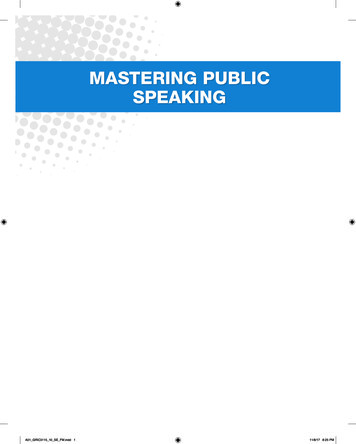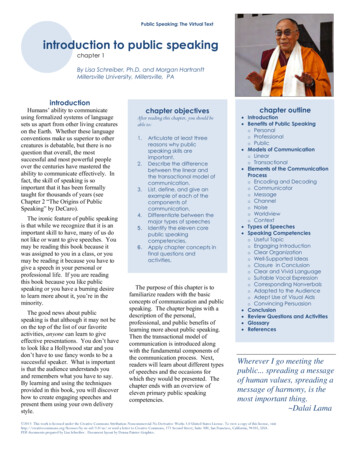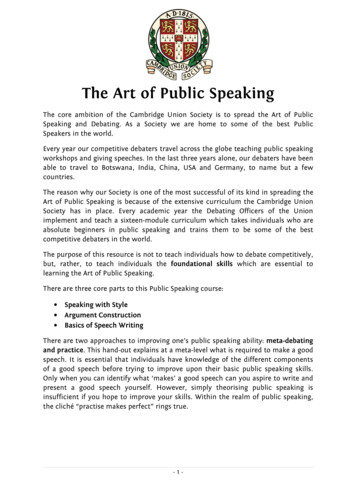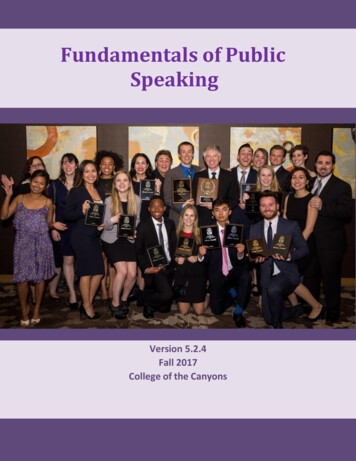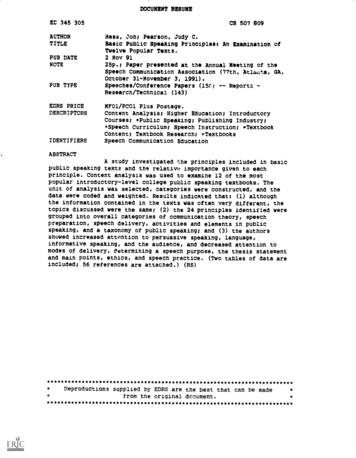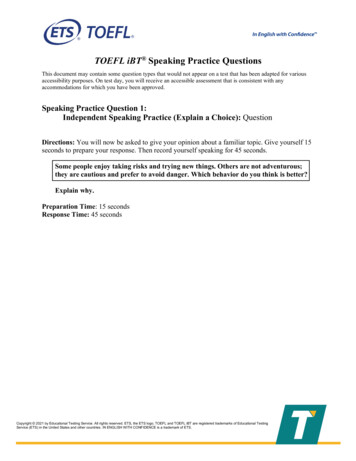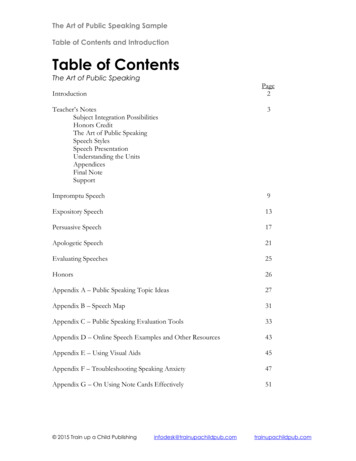
Transcription
The Art of Public Speaking SampleTable of Contents and IntroductionTable of ContentsThe Art of Public SpeakingPage2IntroductionTeacher’s NotesSubject Integration PossibilitiesHonors CreditThe Art of Public SpeakingSpeech StylesSpeech PresentationUnderstanding the UnitsAppendicesFinal NoteSupport3Impromptu Speech9Expository Speech13Persuasive Speech17Apologetic Speech21Evaluating Speeches25Honors26Appendix A – Public Speaking Topic Ideas27Appendix B – Speech Map31Appendix C – Public Speaking Evaluation Tools33Appendix D – Online Speech Examples and Other Resources43Appendix E – Using Visual Aids45Appendix F – Troubleshooting Speaking Anxiety47Appendix G – On Using Note Cards Effectively51 2015 Train up a Child ldpub.com
The Art of Public Speaking SampleIntroductionAn Essential for Every High School Studentublic speaking, like essay writing, is one of the essential courses that we believe every highPschool student needs. The importance of public speaking has little to do with high schoolcredit and more to do with developing an important and useful life skill. Most adults haveto speak before some type of audience whether at work, church or social events. Mostimportantly, this course is designed to help a student develop confidence and passion for sharing histestimony with others. While we would never negate the power of the Holy Spirit in such situations,we firmly believe that God gave us knowledge and tools to use in advancing His kingdom and weshouldn’t neglect sharing those skills with our children.With our high school curriculum, The Art of Public Speaking, your student will learn to preparefor and present four types of speeches: impromptu, expository, persuasive and apologetic. Thiscourse is designed with step-by-step, detailed instructions for both the student and teacher providinga clear picture of each speech style along with solid goals and objectives. Even parents who do notview themselves as strong speakers or writers can teach this course because the evaluation sectiondescribes exactly what you need to look for in your student’s speeches and explains how todetermine a fair grade, as well. The evaluation forms and rubrics make it simple for anyone todetermine the appropriate value or grade of a presentation.Other significant highlights include: An introduction with information about the steps to successful public speaking and how tofully use the curriculum. Speech units including definitions, goals and objectives, advanced preparation ideas and stepby step instructions for writing and presenting each speech. Step by step instructions focusing on topic selection, creating a strong thesis, using a speechmap to organize main and supporting ideas, practicing and presenting each speech type. Evaluation forms and directions, rubric usage and recommendations for the teacher whenobserving and grading speeches. The opportunity to utilize the course for honors credit. Appendices containing helpful tools such as:o topic idea lists 2015 Train up a Child ldpub.com
The Art of Public Speaking Sampleo speech map for simpler organizationo evaluation forms and rubricso online sample speeches and resourceso using visual aidso tips for dealing with common public speaking issueso how to use note cards.Your student will not need to fear public speaking or sharing his testimony after taking this course.By using The Art of Public Speaking, you can provide him with the necessary preparation and speakingskills that will support him beyond even college, into adult life.Teacher’s NotesWe recommend that students taking this course also take the Essay Styles course or a similar classbecause speeches are structured similarly to essays. The two courses could also be of value to thestudent if taken concurrently.The Art of Public Speaking is typically taught in one semester and most often considered anacademic elective. Although strong writing and research skills will benefit a student in this course,the focus is still primarily on the presentation of the speech. A student with weak writing or researchskills will probably need assistance with developing speech material.One of the best resources a teacher can utilize when teaching this course is the Internet. Alarge number of speeches of every sort are available for listening and viewing at no cost. Manydifferent people have performed famous historical speeches, such as The Gettysburg Address, allowingstudents to hear material from a time when audio recordings were not available. College students areoften required to put their speeches on youtube.com for other students to critique. While wecertainly do not condone all of the material available on youtube.com, we do believe that using thoseresources in a positive and specific way makes sense. Many websites, such as americanrhetoric.com,offer a wide variety of speeches for listening and viewing. Apologetic speakers, often famouspreachers and authors, provide recordings of their sermons and speeches free online. We soappreciate the works of such current greats as John Frame and John Piper, not to mentionwonderful messages left behind by C.S. Lewis, Jim Eliot and others. 2015 Train up a Child ldpub.com
The Art of Public Speaking SampleSubject Integration PossibilitiesAs previously noted, it is possible to teach this course concurrently with Essay Styles, beginning thiscourse second semester to coincide with the timing of teaching the expository and persuasive essaytypes. Public speaking can actually be integrated with almost any humanities course, from history toliterature, by having students learn and recite famous speeches, poetry or literary works.Honors CreditOne option available with this course is Honors credit. It is best to decide ahead of time if yourstudent will be following an honors track with this course. An Honors curriculum should be morechallenging and time consuming, typically requiring higher level thinking skills and more effort.Ways to make this course honors include the following: The topics chosen should be challenging, often requiring more extensive research. Longer speeches aren’t always better, but honors students should strive toward more highlydeveloped speeches edging toward the higher time limit. The expectations for evaluation should be higher with the student working diligently,improving with each speech. The student should give several more impromptu speeches and add a famous historical orapologetic speech.The Art of Public SpeakingPublic speaking often challenges students, and adults, because it incorporates many different skillsfrom organizing and researching to writing and presenting. Overall, students should be able tocompetently do the following in order to succeed and grow in this course: select a topic that is appropriate for the speech style complete appropriate research write a thesis statement or question utilize the speech map to organize main and supporting points use note cards without reading from them create a presentation that is articulate and complete.It is imperative that students work through each and every step of preparation andpresentation of a given speech. Even if a student is talented enough to speak without notes, it is 2015 Train up a Child ldpub.com
The Art of Public Speaking Sampleessential to develop these skills for more challenging work in the future. Initially, the teacher shouldevaluate each step of the process to make sure that the student is completing it thoroughly andcorrectly.Speech StylesThe styles of speeches studied in this curriculum include impromptu, expository, persuasive andapologetic. A very brief description of each might be:1. Impromptu – a shorter speech where the student only has a few minutes to prepare.Typically the topic is assigned by the teacher right before preparation time begins.2. Expository – in this speech, the speaker enlightens, teaches or defines a topic.3. Persuasive – a style of speaking that is used to argue a specific point with strong support.4. Apologetic – a type of persuasive speaking where a person defends some specific aspect ofhis Christian faith.The speeches are assigned in order from least to most difficult, for most students. Each unit of thiscurriculum focuses on one particular speech style with the ultimate goal being presentation of thatspeech.Speech PresentationThe emphasis in this course is based on the actual speech presentation. However, it is essential thatteachers stress the importance of the steps of preparation, even if they are not to be individuallyevaluated. For example, a student who neglects to research may find that his speech is weak andlifeless, even though his speaking skills may be very strong. Or a student who doesn’t use the speechmap may find himself giving a poorly organized speech. Preparation and practice increase the valueof any public speaking endeavor.Understanding the UnitsEach of the speech units is similarly designed and follows in chronological order as it is to becompleted. Pay particular attention to who is to read each section, as some sections are written tothe teacher, some are to be read by both the teacher and the student, and some are written directlyto the student. For clarity, the sections written directly to the student will be indicated throughoutthe curriculum by a light bulbat the beginning of the section. 2015 Train up a Child ldpub.com
The Art of Public Speaking SampleFor this course, the evaluation sections follow the impromptu speech unit and the lastformal speech type. Since evaluation for each formal speech is so similar, we’ve designed thatsection for teachers to utilize that is applicable to every speech. Specific tools for evaluation andgrading are in Appendix C, which include evaluation forms and rubrics.The unit sections are as follows: Timeframe for Completion – this is an estimate for the average student. Your student may needmore or less time, which is fine as long as the work is properly completed. This is anexcellent opportunity for high school students to learn to set and meet deadlines. If you’reteaching this course to more than one student you may want to divide students intopresentation groups so they are not all presenting on the same day. Definition – While this portion is mainly written to the teacher, it should be read and discussed by theteacher and the student prior to beginning each speech. The definition is a vital component forunderstanding the type of speech. Tips for speaking – Directed to the student, these tips are different with each speech, but focuson specific skills that will enhance the quality of the student’s presentation. Speech details – These details, written to the student, more clearly define the requirements forthe specific speech in an easy to read bullet format. Objectives – While written to the teacher, these three types of goals should be read andunderstood by the student, as well. They provide direction for what the student shouldaccomplish with each speech type and also focus on what will be evaluated duringpresentation. Advanced Preparation – Written to the student, this activity is designed to help the studentbecome familiar with the speech type by listening or viewing other speeches. It may allow astudent to have a clearer picture of a particular speech style and provide an example ofstrong speaking. Assignment steps – Written for the student to follow, they provide detailed instructions on howto prepare for a presentation. In order to comply with copyright law, students from different families need to purchase their own set of The Art ofPublic Speaking curriculum. Contact us about volume discounts for co-ops and schools and other groups atinfodesk@trainupachildpub.com . 2015 Train up a Child ldpub.com
The Art of Public Speaking Sample Evaluation – Written to assist the teacher, this procedure was designed to make the evaluationprocess easier and more understandable for both the teacher and the student.AppendicesThroughout the curriculum there are references to the Appendices for topic lists, speech examples,resources, a speech map template, evaluation tools troubleshooting public speaking issues and usingnote cards effectively. We suggest you become very familiar with this section before beginning toteach as it will help solidify each speech style in your mind and give you confidence to properlyevaluate your student’s presentation. If your student is using visual aids, be sure to refer toAppendix E. If you have a student suffering from anxiety related to public speaking, readAppendix F with your student for tips to overcome fear.Final NotesAs with any curriculum, it is important for the teacher to read it thoroughly prior to teaching. Werecommend reading through the material one time and then re-reading each unit before beginning toteach it. Being familiar with the curriculum will aid with both teaching and learning.With Public Speaking, the student needs to focus heavily on the preparation and practice forthe best presentation possible. The amount of time that your student commits to practicing hisspeeches will be evident in the overall presentation. We encourage all students and teachers not toskip steps. Public speaking is not only useful for academic purposes but also contributes to theability of students to articulately communicate throughout life. May God bless your endeavors!SupportIf you have any questions about how to use this curriculum, please contact us atinfodesk@trainupachildpub.com and we will get back to you within one business day. We are hereto help you ******************************* 2015 Train up a Child ldpub.com
The Art of Public Speaking SampleThe Impromptu Speech and its EvaluationImpromptu SpeechSpeaking “off the cuff”Note: For a list of possible impromptu topics, see Appendix ATimeframe for Completion: Periodically, throughout the course, with a minimum of fourimpromptu speeches.Definition:An impromptu speech generally allows for minimal preparation but also tends to be shorter thanother speeches. For the purpose of this course, the student is allowed a choice of three differenttopics, with fifteen minutes to prepare and then, must give a speech of 1-3 minutes. The topicsshould not require research, allowing the student to rely on his own knowledge of the subject.Note: A more formal type of impromptu speaking, commonly practiced in high school, isextemporaneous speaking. These speeches are often given in a competitive format, as with debateor forensics, and have very strict guidelines. The student often chooses from a list of 3-5 questions,all related to current events, and uses research and resources that he has acquired in preparation.Allowed preparation time is often around 30 minutes. The speech is generally persuasive, lastingapproximately seven minutes. Some extemporaneous events allow for teams to participate. As this isnot a forensics course, we will not be utilizing extemporaneous speeches, but felt that anintroduction to this style is relevant, especially for students who might consider participating indebate.Tips for impromptu speaking:1. Relax! This form of speaking is not formal and should be entertaining for both the speakerand the audience.2. Start with a simple Speech Map. See Appendix B for a Speech Map template.3. Limit your points. With only 1-3 minutes to speak, focus on 2-3 main points. 2015 Train up a Child ldpub.com
The Art of Public Speaking Sample4. Be sure to provide support. Your points may be excellent, but make sure you clearly supporteach with examples or knowledge. Don’t assume that the audience knows what you mean;provide supporting information.5. Use your gifts. If you have a strong sense of humor or great story telling skills, use thosegifts to make your speech even more effective.6. Stay within the time limit. Students most often lose points by being under or over the timelimit, so don’t disregard it.ObjectivesOrganizing:1. The student will quickly and methodically organize a short speech within a fifteen minutetimeframe.2. The student will include obvious points and have a clear thesis or goal for his speech.Standard Speaking Skills:All standard speaking skills are followed. See the impromptu evaluation form in Appendix C forspeaking skills to be evaluated.Impromptu Format Related:1. The speaker chooses a topic from the presented selection.2. The speaker uses only fifteen minutes for preparation and outlining.3. The speaker stays within the 1-3 minute time limitation.Steps for an Effective Impromptu Speech:1. Choose a topic you understand thoroughly. If you are challenged by all of the topic options,choose the one with which you are most comfortable. Use the speech map in Appendix B to helpoutline your speech quickly.2. Develop a thesis or goal immediately – Choose one very specific point that can be derived fromyou topic. Don’t worry if your thesis seems obvious. The point of an impromptu speech is to thinkon your feet and communicate well under pressure. 2015 Train up a Child ldpub.com
The Art of Public Speaking SampleExample - Three topics including:1. Values learned through baking2. How to be a supportive big brother/sister3. The most important skills needed to succeed in high schoolObviously, if you’re not an older sibling, you could eliminate number 2, unless you’re a youngersibling who could make some valid points! If you’re not interested in baking, definitely eliminatenumber 1 because it will require more thought. The third choice should be an option for almost anyhigh school student.3. Establish your main points. Develop 2-3 main points that support your thesis. If you try tosqueeze in more than three points, your speech may seem rushed and confusing. If you feel you’llhave enough time to plan and present four points, you can also eliminate the fourth point if yourtime becomes tight.Example – I chose “Lessons I learned through baking” and my main points include: Following directions Precision Patience4. Create support evidence. You’ll want 2-3 pieces of support for each of your main points. Supportevidence can be in the form of personal experience shared through a short (very short!) anecdote,statistics and facts that you already know to be true and generally known information to which youraudience can relate.Example – The following evidence could support my points if presented properly: Following directions – unlike other forms of cooking, baking requires specific ingredients and procedures inorder for the baked goods to turn out properly. My examples might include melting butter when makingcookies rather than softening it as in the directions. Melted butter often makes cookies flat and burn easier. Precision – While a stew or casserole might allow you to toss handfuls of ingredients in the pot withoutconcern for measurement, baking requires exact measurements. Too much or too little yeast can cause adverseeffects to the quality of bread. Patience – In many cases, baking involves multiple steps including times where ingredients need to just sit.Example would be bread rising. Also, having to smell baked goods and not being able to eat them 2015 Train up a Child ldpub.com
The Art of Public Speaking Sampleimmediately requires patience (present humorously). Many baked goods must also cool thoroughly beforecutting or slicing and that definitely allows for patience practice!5. Remember your speaking basics. Speak clearly, make eye contact and avoid repeating words suchas “um” and “like.” Review the evaluation form for impromptu speeches in Appendix C to insurethat you have a clear understanding of what is expected of you.6. Don’t panic! Even if every thought leaves your head as you begin speaking, just take a deep breathand give it a shot. Impromptu speaking is a skill that will definitely improve as you practice it. You’llhave multiple opportunities as you study this subject to give such speeches.7. Learn from your evaluations. Do your best and then take your evaluations seriously to help youimprove. Learning to respond positively to criticism is a maturing process but remember that yourgoal is to do a little better with each impromptu speech.Evaluating Impromptu Speeches: This type of speech is probably the easiest to evaluate. Remembering that the student isspeaking without much preparation is important. Also, the goals of this type of speaking are:to build confidence, develop experience and think quickly. Early in the course, impromptuspeeches should be graded much more graciously than later speeches.Using the Impromptu Speech evaluation form in Appendix C provides an organizedand easy method for grading. The numerical values correspond to the rubric system so yourgrades for these shorter speeches can be consistent with the grades for the formal speeches.We recommend combining these evaluation grades at the end of the semester to equal thevalue of one formal speech grade. Remember, improvement should be the overall goal asyou evaluate a student’s progress with this type of speech. Be sure to go over the evaluation with your student after the presentation. It’s usually best topoint out the positives and then select one or two areas to work on with the next impromptuspeech. Students should give at least one, ideally two, impromptu speeches before presenting a fulllength formal speech. 2015 Train up a Child ldpub.com
The Art of Public Speaking Sample We recommend not doing more than one impromptu speech in a day’s **********************************************This is the end of The Art of Public Speaking sample! If you have any questionsabout this or any of our other courses, we would love to hear from you at theemail address at the bottom of the page. 2015 Train up a Child ldpub.com
The Art of Public Speaking is typically taught in one semester and most often considered an academic elective. Although strong writing and research skills will benefit a student in this course, the focus

